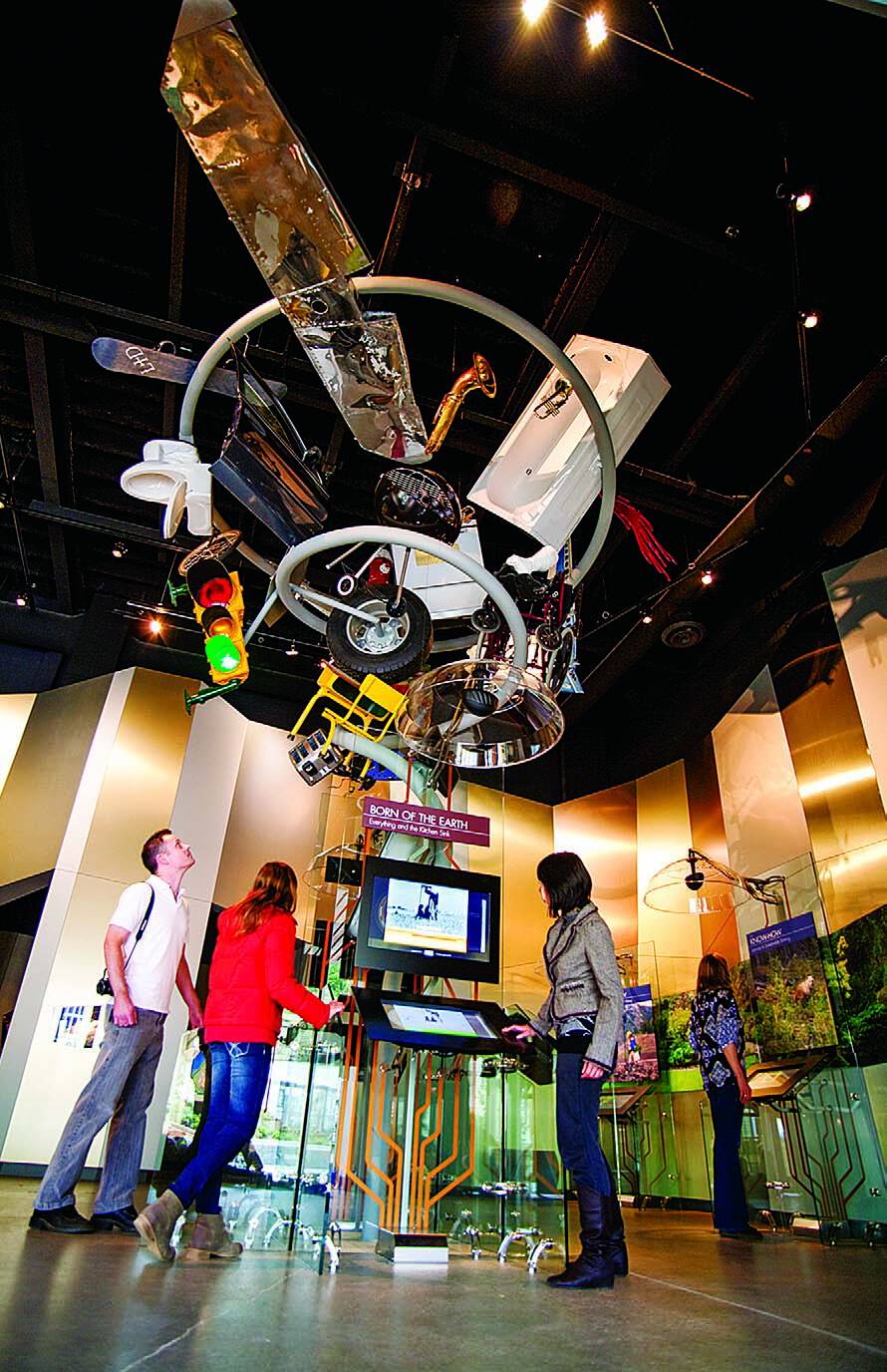One of the first things visitors to the Britannia Mine Museum see is a room dedicated to mining’s contribution to daily life. A spiralling installation rises above the display floor, carrying some of mining’s end products – satellites, desks, toilets and chairs – into the sky. The idea is to educate people about the impact of mining in society, a continuously evolving and expanding contribution.
The Mineral Information Institute estimates that every child born in North America after 2011 will consume 575 tonnes of non-fuel minerals during its lifetime. While the majority of those minerals will be in familiar uses – iron in buildings, copper in electrical wires and zinc in sunscreens – more and more uses for minerals and metals will be in surprising ways and places.
“New technology will continue to provide the world with applications using many mineral commodities and materials made from minerals,” says John DeYoung, director of the National Minerals Information Center at the US Geological Survey. “But what will be used to build these devices? Machinery built from steel, aluminum and many of the other materials that we take for granted today.”
While the majority of what’s dug up in B.C. ends up in traditional places, a growing percentage will end up being used in alternative energy, medical delivery, sterilization, touch screens, microelectronics and any number of other ways.

One of the most striking examples of this is the growing interest in B.C. graphite. One of the strongest and stiffest materials, graphite, like diamonds, is essentially a stable form of carbon long used in pencils, as a dry lubricant, for toughening steel and many other uses. As processing and production methods become more efficient, it is increasingly used in sporting equipment, where it is prized for its light weight and stiffness in everything from race car bodies and sea kayak hulls to mountain bike frames and tennis rackets.
But it is the alternative-energy industry that holds the most promise for B.C. producers. In 2007, Eagle Graphite Corporation, a private B.C. company, reopened the Black Crystal quarry near Nelson, now one of only two North American graphite mines. Along with some aggregates, the mine produces high-quality flake graphite, an important component in fuel cells, hybrid vehicles and, increasingly, other microelectronic applications. More recently, Fortune Graphite Inc. acquired a large chunk of land nearby and has moved the property to the advanced exploration phase for flake graphite as well.
Gold, too, increasingly ends up in interesting niches. The World Gold Council says electronics and semi-conductor industries now dominate the demand for gold, using it for wiring, plating and soldering in electronic components. Beyond these uses, the most excitement comes from the health industry. Ingestible gold salts have anti-inflammatory properties and have been prescribed to treat arthritis and other ailments for hundreds of years. Now, bio- researchers are investigating using a nano-film of gold around drugs to help target cancerous tumours directly. A gold pill, if you will.
Meanwhile, in Scotland, detectives and forensic experts at the University of Abertay Dundee partnered to develop a technique for using gold to lift fingerprints from clothing. “Fingerprints have been used as a means of identification for over 100 years, but recovering fingerprints from fabrics has always proven to be fairly difficult,” says Paul Deacon from the Scottish Police Services Authority. “We wanted to change that.”
“We take these fabrics, place them in a vacuum chamber, then heat up gold to evaporate it and spread a fine film over the fabric,” explains Joanna Fraser, a forensic science researcher at Abertay Dundee. “We then heat up zinc, which attaches to the gold where there are no fingerprint residues. This helps reveal the fingerprint; where contact has been made we see the original fabric, where there was no contact we’re left with the grey colour of the metal film.”

Zinc’s uses extend beyond fingerprinting to many facets of the average person’s life. It is important as an additive to iron and steel to prevent rusting; as an alloy, for instance with copper to form brass; and as an additive in rubber. It’s a common and powerful ingredient in sunscreens, is often used for treating skin conditions, including acne, and has major health benefits, particularly for boosting immune function.
In partnership with copper, zinc is also a proven bacteria fighter. To reduce the spread of bacteria in commercial and hospital environments, copper alloys are often used on doorknobs, shopping cart handles and other frequently touched places. Research suggests 355 copper alloys have been proven to kill 99.9 per cent of disease-causing bacteria within two hours.
Along the same lines, zinc and copper team up with silver to fight bacteriacausing odour in a host of products from shoe footbeds to workout wear. Silver ions are the dominant player for Agion, one of the companies using silver to fight bacteria in a range of settings. Contained in a polymer coating, the silver ions attack the microbe to prevent it from reproducing, thus limiting the odour and spread of disease. Beyond fighting funk in your sneakers, Dell is using Agion to protect keyboards on a line of computers designed for the heavy-use educational environment. It’s also incorporated into birdfeeders, metal cabinetry and diaper bags.
Another surprising use of silver is in the Oddy test, a process used by art galleries and museums to determine if offgassing from construction materials and display cases could damage art. The test isolates silver, lead and copper and the material to be tested. The silver detects corrosive sulphur compounds; lead detects organic acids, aldehyde and acidic gases; and copper reveals the presence of chlorides, oxide and sulphur compounds.
And finally, there’s the B.C. mining industry’s most humble of elements, molybdenum. Mostly used as a hardening agent in steel alloys, it is showing promise in agriculture, where it plays a natural role in nitrogen fixing. Research suggests adding small amounts to crops can increase the shelf life of produce, decrease insect pressure and reduce the amount of other fertilizers needed, all while increasing yields.
Molybdenum’s importance in plant growth has been only recently exposed, pointing to a trove of untapped and, as yet, unknown uses and value for mined materials. Like B.C.’s graphite industry, new demand may create new opportunities for exploration and development in B.C. Who knows what area of our lives mining may touch next?
